ARTICLE DATE: 1987
AUTHOR: Stormin’ Norm Goyer
While Thousands Of Us Have Enjoyed Ken Brock’s Gyrocopter Performances At Airshows All Over The Country, Few Realize The Tremendous Dedication Of The Brock Family To Recreational Flying
I first met Ken Brock sixteen years ago at El Mirage Dry Lake in the Mojave Desert near Ed wards Air Force Base. I was there filming a documentary for the Motorcycle Industries Council, and Ken was, as you may well have guessed . . . flying his gyrocopter.
Because, back in Massachusetts, I had observed so many floundering attempts at flying the Bensen gyrocopter, and had even witnessed two fatal accidents involving them, I wasn’t very impressed when I saw Ken in his aircraft. That is, until Ken started putting his whirlybird through its paces. As I watched awe-struck, I realized that Ken was a virtuoso at flying his bolt-together rotor aircraft.
Throughout the years, while covering airshows all over the country, I saw Ken putting on his superb performance many times, and each time I watched him, I became more and more aware of how well he knew his aircraft, and I was also impressed with the fact that he was, at all times, extremely safety-conscious.
At the end of each of his performances, he would wait until the rotors slowed down, then he would reach up and slow them further, until they came to a complete stop. Only then did Ken leave his aircraft. I learned that Ken was an expert machinist, and observed at close range that his version of the Bensen gyrocopter was a work of art.
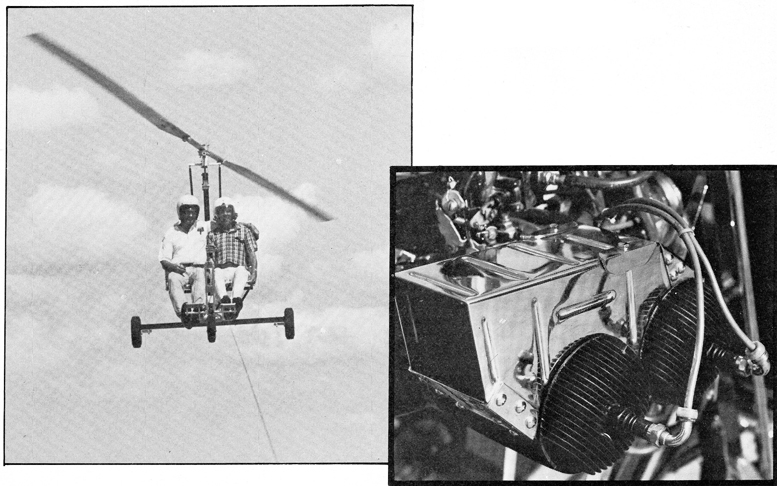
LEFT: Ken with a student, being towed in a KB-2G. This is the first machine which a new student rides in.
RIGHT: The four cylinder McCullough engine in Ken’s show plane is heavily chromed for appearance.
It was at the Merced, California, Fly-In in the spring of 1986 that I met Ken again. He introduced me to his beautiful wife, Marie, and answered my questions about his Stinson 108-3. Realizing at once that aviation enthusiasts everywhere would find his story as interesting as I did, I asked him for an interview. He graciously agreed, and we made arrangements to meet within the next few weeks.
You can imagine my surprise and shock when, the weekend before our meeting was to take place, I picked up a newspaper and read that Ken Brock had been critically injured while exiting his gyrocopter at El Mirage.
The newspaper and television accounts were sketchy, although they said that, another gyrocopter pilot was killed when his craft hit some wires at the end of the field. The sport aviation community was shocked. How did it happen? We had all watched Ken fly, and none of us could figure out the reason for this accident.
I was relieved to learn from his friends, over the next few weeks, that Ken was steadily improving, and would be all right. About six months after the accident, Ken made his first flight, and as soon as I learned about it, I made another appointment to meet with him and Marie at his place of business, Brock Manufacturing in Stanton, not far from Disneyland.
SPORT PILOT: Ken, how did you first get into sport aviation?
KEN BROCK: I was a private pilot, and I had a small machine shop. One day, while I was thumbing through some aviation magazines, I saw an ad for Bensen Gyroplanes, and it interested me right away, be cause you not only could learn to fly it, you could fly it out of your own backyard. So I ordered the plans, and in my spare time, I built one in the machine shop. That was in the latter part of 1957.
SPORT PILOT: Did you ever get involved in any other part of aviation, such as antiques, homebuilts, or racing aircraft?
KEN BROCK: I most certainly did. I got quite involved. I built two Thorpe T-18s, a Miniplane, an Akro Sport and rebuilt a 1948 Stinson 108-3. I rebuilt that Stinson many times, and it has won awards at the various Fly-Ins all over the country; in fact, it won “Grand Champion” at the Stinson Meet in Minden, Nebraska, last year.
ABOVE: Ken used this film to instruct his gyro students in the 1970’s. Times have changed and dual instruction is now available. Self instruction can be very dangerous.
SPORT PILOT: While you were building your Bensen from factory drawings, did you realize right away that this aircraft had a great potential for fun flying?
KEN BROCK: Yes, it was fun, and my little Bensen attracted a lot of attention whenever I’d demonstrate it at fly-ins everywhere … I represented Bensen for about five years. But, as I flew the aircraft, ideas for improvements kept coming to me, and I’d add them.
There was the patented seat-fuel tank, the aircraft-type joy stick (rather than the overhead system), and many others. It wasn’t long before there were so many changes that it was a different machine, and it was at this point that we broke away from Bensen in the latter part of the 1960s.
SPORT PILOT: Was it always a peaceful co-existence between you and Igor Bensen?
KEN BROCK: Oh yes, and it still is . . . have an excellent relationship; I respect the man highly, but there was this need for us to go on a different route, so we just broke off.
SPORT PILOT: What’s Bensen doing now?
KEN BROCK: Igor still has his plant in North Carolina; he’s had to relocate it from the Raleigh/Durham Airport, but he’s still in that area.
SPORT PILOT: No pilot likes to talk about it, but there have been many serious accidents involving gyrocopters. What can be done to make this a safer flying category?
KEN BROCK: We’ve been involved with safety since day one. The most important thing everyone can do to promote safety is in the training it self. We have always offered training because we knew that the biggest downfall from the beginning, in gyroplanes, was lack of training. It’s a different machine . . . you can even take a 4000-hour pilot and place him in a gyroplane, and he’ll still need training.
SPORT PILOT: Before we go any further . . . for those of our readers who may not know these facts . . . would you please explain the different types of rotating-wing categories, as recognized by the FAA, and their distinctions?
KEN BROCK: The name “Gyrocopter” is a Bensen proprietary trade name. The correct category is Gyroplane. There are two rotor craft categories listed by the FAA: One is a Helicopter; the other the Gyroplane.
SPORT PILOT: Where do your aircraft fit into the FAA rules?
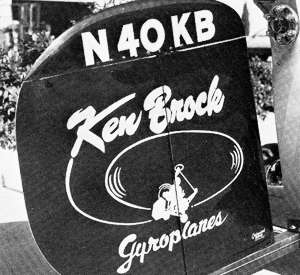
The short-coupled tail, and small diameter prop are evident in this rear view of Ken’s show machine.
KEN BROCK: They all qualify for Home built, and we’re the only company in the world with a model which qualifies as a true Ultralight. About one and a half years ago, at a gyro plane meet in Illinois, they set up scales, and the black machine over there (which I fly in my demonstrations) weighed in at 230 pounds. The closest one next to it weighed 260 pounds. (FAA weight limit for Ultralights Part 103 category is 254 pounds.)
SPORT PILOT: Doesn’t the chrome and black machine have performance figures greater than those allowed in Part 103?
KEN BROCK: Yes, but the aircraft is listed as a Homebuilt, if anyone wanted to fly under Part 103, all they would have to do is pitch the rotor blades and re-pitch the prop to lower the top speed to set limits.
At the afore mentioned meet in Illinois, we realized that other companies were calling their rotorcraft’ an Ultralight when they put a modern 2-stroke snowmobile engine in it … so we backed up into the Ultralight category by building a machine with a more dependable, water-cooled, Rotax 2- stroker, which is still a true Ultra light, and yet has all the features of our very popular Homebuilt machines.
This is the machine we call the KB-3. I went over to Austria and came back with a Rotax 532 liquid-cooled 2-stroke engine. I was very impressed with the Austrian factory’s personnel and I’m still very impressed with the engine.
SPORT PILOT: I notice that your exhibition machine still has the old McCullough 4-cylinder Under drone engine.
KEN BROCK: Yes, my exhibition machine, my KB-2, is actually lighter than the Ultralight KB-3. The McCullough is a very light 4-cylinder, 2-stroke engine and there is no other engine in the world which can touch it in a power-to-weight ratio.
The Rotax is a good engine, but it’s 2-cylinder 2-stroke, liquid-cooled, and you need a gear box to lower the propeller rpms down to a usable number. And that spells weight. The KB-3 Ultra light out-weighs my KB-2 by seven pounds.
SPORT PILOT: What’s the history of the McCullough engine?
KEN BROCK: Originally, the (WWII) drones were built by Northrop and powered with the McCullough engine. In 1970, McCullough dropped the engine, because they only ran the line once or twice a year, and the operation took up to 2500 to 3000 square feet . . . not a cost-effective operation for them.
So they offered the engine to Northrop, Beechcraft, and to Brock Manufacturing. We we quite interested in it, but seeing that Northrop had the drone contract, they accepted the engine, and are still producing it at this time.
SPORT PILOT: There have been two certified autogyros offered to the public, the Umbaugh, and the McCullough, and they both failed. Why do you think this happened?
KEN BROCK: Well, Don Farrington from Kentucky now holds the right to the Umbaugh and McCullough used a design by Gimonivitch. He’s also the designer of the rotor head for the Hughes Helicopter. And one of its shortcomings, I think, was that, to expedite the certification process, they used the Hughes blades and rotor head which had already been certified for helicopter operation.
SPORT PILOT: From the days of the Ciervas, Kelletts and the Pitcairn . . . how much has the technology advanced?
KEN BROCK: You know … I don’t think it has advanced. The early autogyros had wings, ailerons, conventional air craft controls, and the rotor head was fixed; all attitude changes were strictly by elevators, ailerons and rudders.
In the late 1930s, Pitcairn and Kellett did bring out models similar to our current models. Control was via the rotating wing or blades. The modern pusher configuration is an advantage, I think, although the tractor versions do have the benefit of being able to swing a larger prop. Most modern gyroplanes have all been pushers, but there are a few sport types flying around with the engine in front.
SPORT PILOT: Do you believe that the Ultralight gyrocopters which are being sold by others will help or hinder your business because they do not have the experience or the quality control maintained by your company?
KEN BROCK: I believe that, as a whole, the Homebuilt movement has helped sport aviation, and the Ultralight movement has brought many into the field who would not otherwise be active if they had to go through licensing procedures. The gyrocopter is much more of a flying machine than any Ultralight ever thought of being.
After you learn to fly it in calm weather, there isn’t a wind blowing in which you couldn’t operate the gyroplane. And this is certainly not true with Ultralights. Everything is going for the gyroplane . . . the set-up time, the maneuverability and the durability are far superior to that of any Ultralight.
SPORT PILOT: If you have an aircraft for sale in your shop, and say, a person comes in and wants to purchase it. Do you analyze that person to determine if you should sell him that aircraft?
KEN BROCK: We haven’t had that situation arise as yet, but we are quite firm with the customers in making it very clear that they should definitely expect to go through some type of training program. We also assist the purchaser with help during construction, but one of our kits has so many sub-assemblies that it’s almost like assembling a bicycle at Christmas time.
There’s nothing to machine; nothing to weld, and it’s even pretty much rigged as it comes out of the boxes. In the case of the pilot, though, flight training or checkout is very important.
SPORT PILOT: What is your program for safety training?
KEN BROCK: We have a recommended one-day course, and at the end of that day, they are qualified to fly the machine, or else we strongly suggest more training. It doesn’t take very long, but it is necessary.
It’s almost like playing a musical instrument . . . the instructor can show you what to do, how to do it, what not to do . . . but how good at it you eventually become is up to you. You must practice the theory taught to you by the instructor.
We get the student up to the point where he or she can taxi, takeoff and get back down. We take one step at a time, but then the student must practice his technique . . . just like learning to ride a bike, drive, or fly a fixed-wing aircraft . . . you have to do it by yourself to become proficient at it.
SPORT PILOT: Is there a critical area in the training of a prospective gyrocopter pilot?
KEN BROCK: Yes, the negative loading; there’s not a gyrocopter made which will withstand this. You don’t see helicopters flying inverted, and very seldom do you see them do loops. Back in the 1930s, Johnny Miller used to perform loops at airshows in a Pitcairn, but this is strictly taboo for a gyroplane or any other rotating wing aircraft.
It is theoretically possible, but if you fall out of a loop, lose your airspeed, and the loads go negative . . . it’s all over. In an air plane, you just fall until you regain airspeed.
SPORT PILOT: What about an in experienced pilot going into a porpoise?
KEN BROCK: If a person is teaching him self to fly, it’s possible that this could happen, and so it has, many times, but, with proper training, it shouldn’t happen at all. The best piece of advice I could probably give to prospective gyroplane builders is that they should get proper instruction from an experienced gyroplane instructor.
Under no circumstances should they try to teach themselves how to fly. The gyroplane is a very easy-to-fly, safe airplane, but like any other aircraft, you must learn to fly it properly.
SPORT PILOT: Are there any kits or plans currently on the market, either in a Homebuilt or an Ultra light category which you do not consider to be a safe machine as represented?
KEN BROCK: As a manufacturer, I’d rather not comment on that question, but I will say that any time you want to do something, and you ask forty people how to do it, you’ll get forty different ways to accomplish that task. And some of those ways will be far superior to others.
SPORT PILOT: What about the skill levels of the persons assembling your kits?
KEN BROCK: We have a complete construction manual which has a photograph with every step. If anyone can read and follow well-illustrated, simple instructions, then they should have no problems. And we haven’t experienced any problems.
SPORT PILOT: What type of raw materials do you use . . . hardware or aircraft grade?
KEN BROCK: It most certainly is all aircraft grade. You must realize that, in our machine shop, we do a lot of aerospace work, and we treat our Homebuilt components exactly the same as we do our aerospace parts.
SPORT PILOT: Are all of the people in your shop skilled machinists, or are they hobbyists?
KEN BROCK: Our people are all very knowledgeable in each of their particular skills, but not machinists. We keep all the certification on all the materials, plating, and whatever outside processing we may require; heat treating, welding, every step is documented, and the documentation stays with the work order. All of our welders are certified in all positions.
SPORT PILOT: In our conversation, you’ve mentioned parts for several different models. Can you be specific about this?
KEN BROCK: Besides our own models, the KB-2 and KB-3, we make many components for the Vari Ezes, Long Ezes, Quickies, Marquart Chargers, T-18s, Akro Sports and others. Any one who sends for our catalog will find all the components which we manufacture listed in it. We also make parts for manufacturers who sell them themselves.
Our own gyrocopters are the KB-2, the KB-3, the KB-2G which is the towed version and new KB-4 in the early stages of prototype. We’re also working on another model which will be float-equipped. The KB-2 is the VW and the McCullough version, and the KB-3 is the Ultralight, Rotax-powered model.
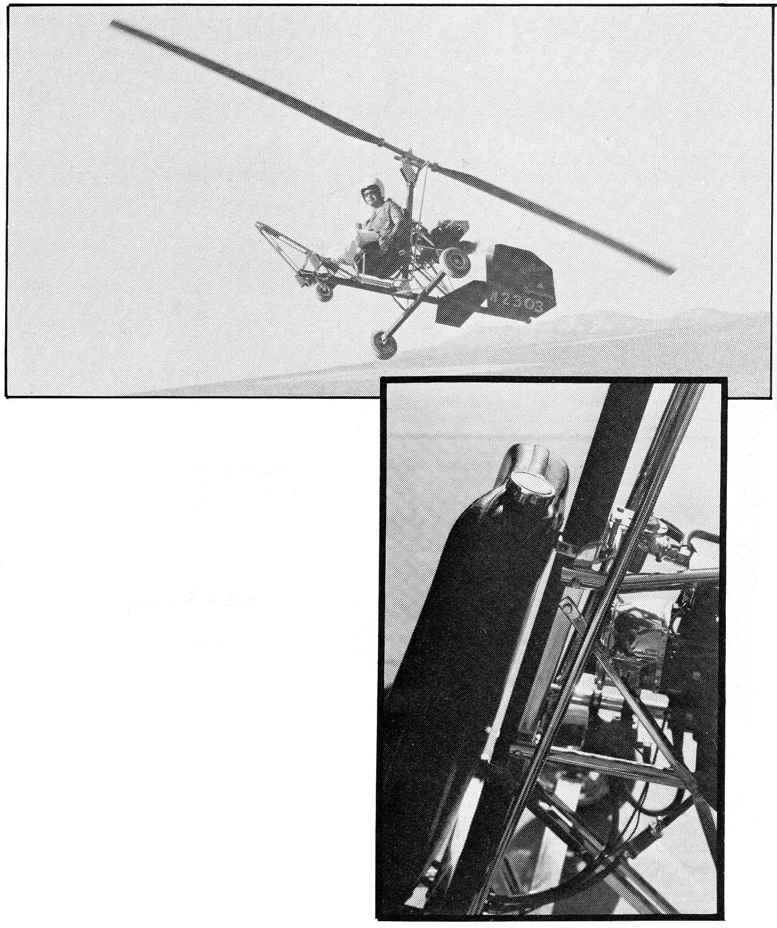
TOP: Ken, as many see him at airshows all over the country. This McCullough- powered machine is extremely maneuverable.
RIGHT: This is the patented seat tank which was one of the first modifications made by Ken on the black KB-2 flown in airshows.
SPORT PILOT: Is the towed version for training?
KEN BROCK: Yes, this is our non-powered, two-place training model in which a student takes his first flight. As you know, there is no power to the blades of a gyroplane, and your power is via pusher engine or a car towing you.
The result is the same, and the towed version is quiet and gives the instructor more control over the very important first flights with a student. The feeling is the same, the weight of the engine is replaced with the second passenger, so the controls still feel the same. We also have a powered two-place training aircraft.
SPORT PILOT: What do you teach the student?
KEN BROCK: Number one is attitude flying; second, control without over-control. We concentrate on those two lessons, and once the student thoroughly understands, and is able to control the plane thusly, he won’t have any trouble.
Over-control is the reason for porpoising, so we stress the avoidance of over-control in our flight programs. In our attitude lesson, we teach the student how to control the attitude of the aircraft through the coordinated use of power and stick movements. We have not really had any problems with our training.
SPORT PILOT: How many hours are there in your course?
KEN BROCK: About three hours for the first phase of the course. The second phase takes place at the student’s own speed, and we’re always there to assist or to answer any questions about techniques which may arise during the student’s first hours of solo flying.
SPORT PILOT: What about maintenance?
KEN BROCK: I’d like to say that our aircraft are maintenance-free, but there is always preventative maintenance, such as carefully looking over every component during the pre-flight check. Other than re-greasing the wheels, there’s little else. The rotor head bearings are all sealed, and need no service. The aircraft should not be left out in the rain, but other than the wheels, it is pretty maintenance-free.
SPORT PILOT: Earlier, you mentioned that the 4-cylinder McCullough was very high in power-to-weight ratio, but how high is it in dependability?
KEN BROCK: Well, I think that it’s very dependable, but people who don’t understand the 2-stroke engine just aren’t aware of the nature of the breed. We’ve had excellent luck with the 2-stroke engines, and most of our customers have had good experiences with the 2-strokes. As you know, I’ve flown from coast to coast with them and have had very few problems.
SPORT PILOT: I’ve heard that the 2-stroke engines do not enjoy a great reputation with the FAA, among others. Do you think that this affects your sales because your engines are 2-strokers?
KEN BROCK: No, I don’t think that this has affected our sales at all, but for those who do prefer a 4-stroke engine, we do offer a VW version. However, when our customers see the tremendous power-to-weight ad vantage of our 2-strokes, many of them change their mind. Our sales figures show that we still sell more 2-strokes than the VW versions, and those facts are hard to ignore.
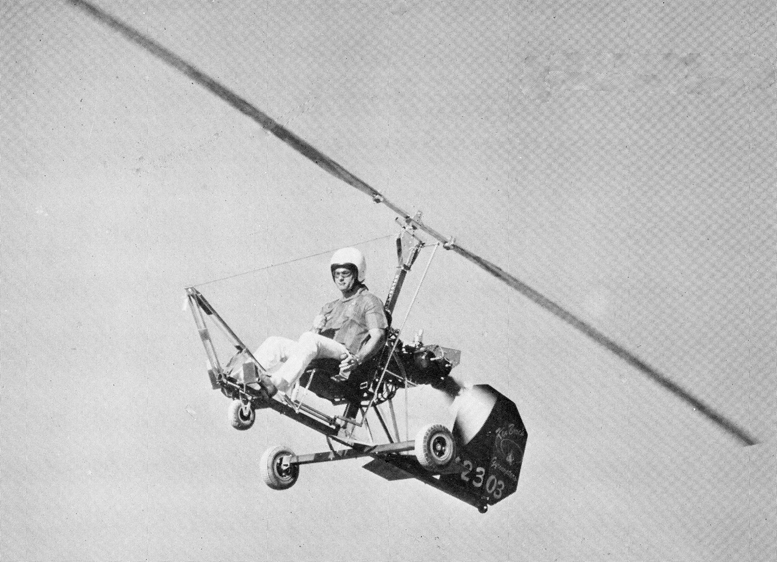
In a light headwind, Ken can land the KB-2 vertically, with almost zero ground roll.
A VW conversion engine is not entirely trouble-free either. Those folks who take the time to understand a 2-stroke know that they have a minimum of parts, and that they’re really a very simple engine, but for best results, everything must be working properly.
SPORT PILOT: How has your relationship with the FAA been over the years?
KEN BROCK: Throughout the last thirty years, our relationship with the FAA has been excellent; we’ve had some problems, but we’ve always been able to straighten them out.
SPORT PILOT: Did you ever contemplate building a “dream gyro copter,” with a plush cabin, multi passenger, cross-country capabilities?
KEN BROCK: Certainly, but I doubt if there is a market for one. Umbaugh and McCullough found that out. In our opinion, every aircraft is a compromise … if you want to go from point “A” to point “B,” then you don’t want a 90 mph gyrocopter.
Without jump takeoff, gyrocopters have limited appeal. Look at helicopters . . . they’ve been around for forty years, and they still don’t have the backyard capability . . . you still have to land at airports or heliports, and most of them are private. I have a Brantley B2B helicopter, and if I have to go to Los Angeles, I’d have to go from airport to airport, then take a car into town.
I might as well take one of my planes or my car. I believe that gyroplanes will always remain recreational vehicles which can be taken apart in five or ten minutes, then trailered back home for storage. At this time, I can’t see that they have any utility use.
SPORT PILOT: Let’s talk about that old bugaboo . . . noise. I’ve seen you perform at many airshows in your McCullough-powered KB-2, and it’s very loud. Is there any way of reducing the sound level?
KEN BROCK: Now we’re talking about several different things, and you’re right about the loud noise. I don’t have mufflers on my airshow ship for a very good reason: Noise is a very important part of airshow performance.
Just think about it . . . without the roar and growls of those big Pratt & Whitney engines, the Allisons, the Merlins, not to mention the din created by the straight-stacked Wrights in the B-25s, airshows just wouldn’t have the same appeal . . . sound is an integral part of a good airshow.
As for the reduction of the sound level for everyday flying, we do feature several mufflers in our catalog. However, a good part of the noise is the prop noise, and that can’t be cut down. At 4100 rpm, the prop moves a lot of air, and the sound is loud.
On the Rotax-powered KB-3, we’re using a prop-reduction gear box, and with a muffler as supplied, the sound is much quieter. This engine turns the prop at about 2500 rpm, which makes the KB-3 a more delightful machine to fly, noise-wise than the McCullough.
SPORT PILOT: Ken, I know our readers will be interested to know what happened about six months ago, when you had the near-fatal accident.
KEN BROCK: Well, as you know, I was flying with friends of mine, and one of them contacted some wires and crashed. I landed as quickly as I could to assist him, and another friend, who was also flying with us, landed alongside me as I was dismounting from my aircraft.
Well, the bottom line is that, even after being around these planes for thirty years, and teaching safety in and around gyroplanes, it looks like, in my hurry to come to the assistance of my friend, I walked right into a rotor blade.
With a gyroplane, you can walk straight out in front of the aircraft, and even with your hand straight up in the air, you will not touch the revolving rotor blade. There weren’t any eyewitnesses to the accident, and the only other person there was landing his plane at the time and didn’t see the accident.
I was standing to the left of the seat, where I normally stop my rotor blades. There is some degree of confusion in my mind as to my witnessing the original accident to my friend, but after landing and learning of the accident, I’m pretty sure that I just didn’t take the time to stop my rotorblades.
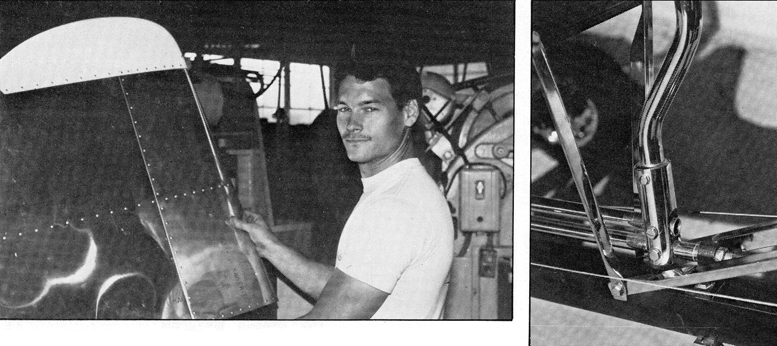
LEFT: Terry Brock, Ken and Marie’s 27-year- old son, works alongside his parents in the shop.
RIGHT: The excellent quality of the machine is evident in the black KB-2 flown by Ken.
When Ron came around and landed, he told me that my engine was stopped, and that I was standing to the left of my machine. He slowed down his landing roll enough to make a 180 degree turn, and when he did, I disappeared. We spent one whole day together, trying to determine just what had happened. We drew diagrams and tried to reconstruct the accident.
What we believe happened is that, when he rolled past me, his prop blast hit my machine, and because my rotor blades were still turning, my machine was lighter than normal because of the extra lift. Now, it’s possible that his prop blast “weather-vaned” my machine, or we had what is known as a “weave” where the blades track in an up-and-down pattern.
In either event, the blades were placed in a position for which I was not ready. I was almost clear of the machine … it was the last foot of the rotor blade which struck me. We don’t really know what happened … that was simply an assumption on our part.
SPORT PILOT: When I first heard about the accident, I thought, no . . . no way did Ken walk into a rotor blade.
KEN BROCK: That was my thought too, when I came to and they told me what had happened … I just could not believe that I had walked into a blade. The only fact we know for sure was that a blade hit me.
SPORT PILOT: Well, you had the good wishes and prayers of thousands of your friends from all over the world riding with you.
KEN BROCK: Well, they certainly helped, and Marie and I are very grateful for the thoughts. I received over 2000 “Get Well” cards, and only two of them stated: “Well, does this finally convince you to give up flying?” I reminded them that this was a walking accident, and I’m not about to give up walking!
SPORT PILOT: Thanks, Ken, for your valuable insight into the fascinating world of gyroplane flying.
| KB-2 Specifications | |
|---|---|
| Empty Weight | 240 lbs |
| Gross Weight | 600 lbs |
| Fuel Capacity | 8.9 gals |
| Rotor Diameter | 22 ft |
| KB-2 Performance | |
|---|---|
| Cruise | 60-70 mph |
| Min. Level Speed | 25 mph |
| Climb | 1200 fpm |
| Range | 150 miles |
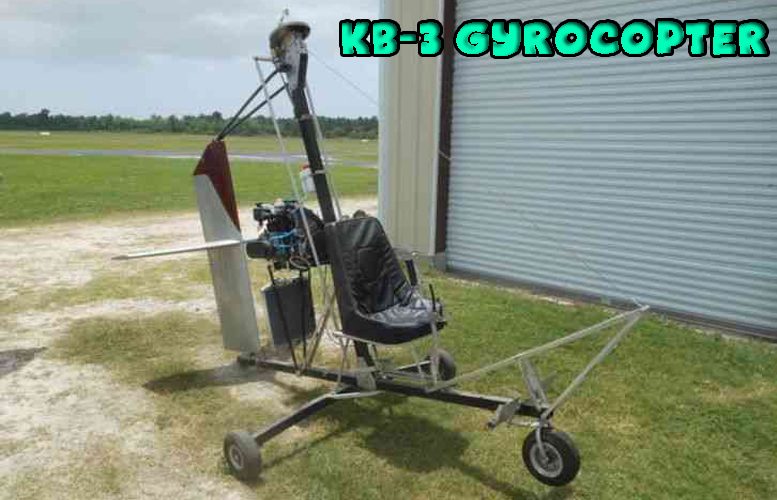
| KB-3 Specifications | |
|---|---|
| Engine | 65 hp liquid cooled Rotax 532 |
| Empty Weight | 250 lbs |
| Gross Weight | 600 lbs |
| Fuel Capacity | 5 gals |
| Rotor Diameter | 22 ft |
| Top Speed | 63 mph |
| Cruise Speed | 55 mph |
| Minimum Level Speed | 25 mph |
| Rate of Climb | 500 fpm |
| Range | 75 miles |
SPORT PILOT: FOOTNOTE – Ken passed away in 2001 when his fixed wing plane crashed on landing due to a mechanical fault, his wife was on board but escaped with minor injuries.
REPORTER’S NOTES: This was my first trip through Ken’s shop. It happened to be that one week, every year, when every one there turns to, and cleans and paints the entire shop . . . machines, floors, walls . . . even the rafters. Every spec of dust is removed, and each of the expensive tools is checked, repainted and replaced.
Ken’s shop is as clean as an operating room. I’m not a machinist or a tool maker, so I couldn’t fully comprehend the scope of the operation, but I was very favorably impressed with the wisdom and knowledge of each person I met, including Ken’s 27-year-old son Terry, who was doing his share of the clean-up operation.
Marie Brock was busy in the office at the computer which keeps the thousands of parts, and thousands of customers identified and organized. I had been told that Ken and Marie Brock and company were a “class act” . . . after my visit there, I can say that I wholeheartedly agree!
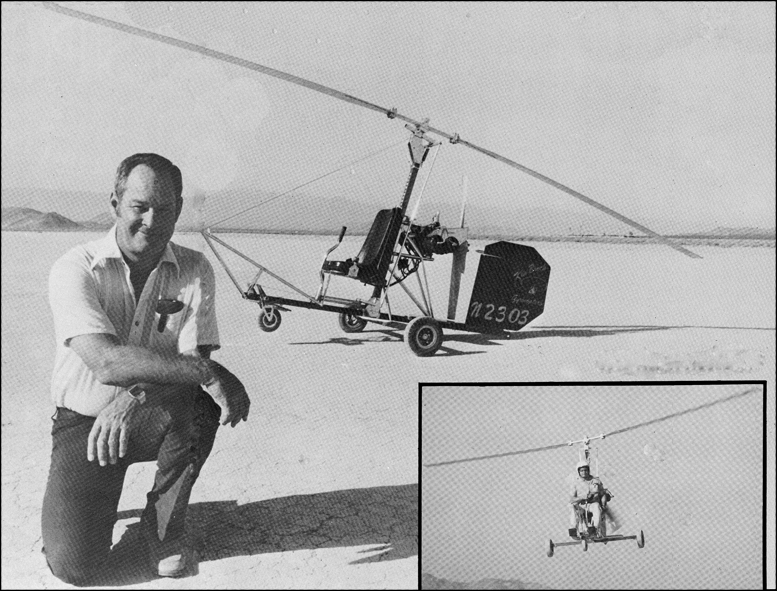
MAIN: Ken and his show machine, the KB-2, at El Mirage Dry Lake in the Mojave Desert near Edwards Air Force Base, California.
INSET: This head-on view shows the tilt of the rotor head which is used for control.
REFERENCE: https://en.wikipedia.org/wiki/Ken_Brock_Manufacturing
REFERENCE: https://en.wikipedia.org/wiki/Brock_KB-2
REFERENCE: https://en.wikipedia.org/wiki/Brock_KB-3
REFERENCE: https://groups.google.com/forum/#!topic/rec.aviation.homebuilt/OObtcvl-2fY
https://www.ancestry.com/genealogy/records/ken-brock-24-m687dg?geo_a=r&geo_s=us&geo_t=us&geo_v=2.0.0&o_xid=62916&o_lid=62916&o_sch=Partners
A Tribute To Ken Brock

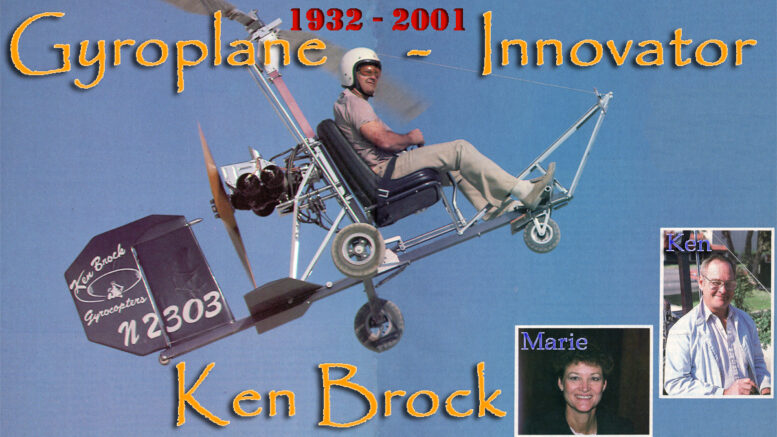




my husband and I worked with Ken Brock and Ed Nelesky during the 60-70’s with these wonderful machines. Brings back old memories, but many fond ones.